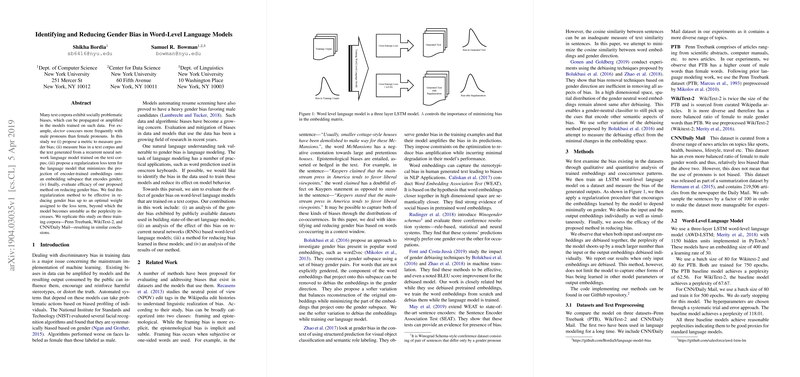An Analytical Essay on "Identifying and Reducing Gender Bias in Word-Level LLMs"
The paper "Identifying and Reducing Gender Bias in Word-Level LLMs" co-authored by Bordia and Bowman investigates an imperative challenge within the domain of NLP: the issue of gender bias embedded within LLMs. This research particularly targets recurrent neural network (RNN) based word-level LLMs, proposing a methodology for the identification and mitigation of gender bias.
Overview and Methodology
Bias in large text corpora is a well-documented phenomenon, often resulting in the propagation or even amplification of these biases in neural LLMs trained on such data. The paper sets out its contributions by introducing a novel metric designed to measure gender bias. The authors focus on word-level LLMs built with RNN architectures due to their prevalence in NLP tasks such as word prediction.
A substantial portion of the research is dedicated to presenting and validating a technique for reducing gender bias in LLMs through a regularization process. This technique involves adding a loss term that aims to minimize the projection of word embeddings on a subspace that encodes gender. This regularization can curtail the bias present in embeddings during the training phase.
The authors further detail their evaluation process for the proposed regularization, producing quantifiable measures of bias in both training corpora and the textual output of trained models. Three corpora—Penn Treebank (PTB), WikiText-2, and CNN/Daily Mail—are chosen for experimentations due to their varied degrees of gender bias, with results providing valuable insight into the effectiveness and limitations of their method.
Results and Observations
The investigation conducted across different corpora yielded consistent results which confirmed the efficacy of the proposed regularization strategy in reducing gender bias up to a certain regularization strength parameter, denoted as . However, it was observed that a stringent application (excessively high ) could destabilize the model, as evidenced by increasing perplexity scores.
The empirical paper underlines that gender debiasing does not degrade the model’s performance significantly at an optimal . In practical terms, this means the technique generalizes reasonably well across different types of corpora while requiring a careful balance between debiasing strength and the overall LLM performance.
The paper’s comprehensive examination of corpus-level and word-level bias showcases the intricate mechanics of gender bias, addressing both explicit and implicit types of biases associated with word usage. This nuanced treatment highlights occupation-related cooccurrences with gender biases—revealing, for example, a higher association of professions with male gender, a bias reduced by the authors' proposed method.
Theoretical and Practical Implications
From a theoretical standpoint, the paper contributes to the ongoing discourse on bias mitigation in machine learning, particularly within the context of NLP. By proposing an operationalizable method built into model training pipelines, this research provides a foundation for subsequent investigations into broader applications including sentiment analysis, machine translation, and autonomous dialogue systems.
Practically, the work serves the growing demand for equitable AI systems which conscientiously avoid reinforcing societal biases. In domains such as automated hiring systems, the amelioration of gender bias is especially crucial in ensuring fair outcomes untainted by historical data biases.
Future Directions
The implications of this research set the stage for future work, urging exploration into evolving architectures beyond RNNs, such as transformer-based models, within the context of bias mitigation. Furthermore, extending this methodology to account for other forms of biases (e.g., racial, ethnic) would be an anticipated research trajectory. The adaptability of embedding debiasing techniques offers a fertile ground for innovation, addressing the pervasive issue of bias in AI comprehensively.
In conclusion, the work presented by Bordia and Bowman makes a meaningful stride in recognizing and addressing gender bias within word-level LLMs. The paper balances theoretical underpinnings with empirical rigor, contributing substantively to the field's advancement toward bias-resilient NLP systems.
